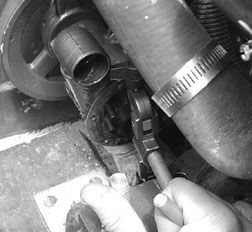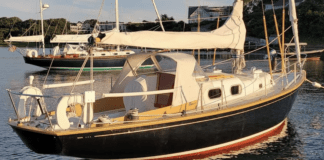
Every few years we mention a product called the Speedseal, because, well, every few years we’re reminded why we need one.
Most inboard engines that are cooled by water pumped from outside the boat have seawater (aka raw water) pumps with nitrile or neoprene rubber impellers. The Speedseal is a replacement for the cover of that raw water pump.
Lest you think such a piece of gear is unnecessary or unimportant or uninteresting, consider the following scenario: You’re cruising along under power, your raw water intake manages to suck a plastic bag up against itself, and within a few seconds, your engine is no longer being cooled. If you were to look over the stern, you’d see no water coming out the exhaust. But you don’t notice until the temperature gauge pegs to the right. Even if you shut down and figure out the cause of the problem before your engine suffers damage, your impeller, having been spinning dry inside the pump bore, is almost certainly shot, and needs to be replaced with the spare you prudently stowed on board (somewhere) a couple of years ago. Add to this scenario choppy conditions, a lee shore, a crew wailing and gnashing their teeth, and you realize that the ability to change an impeller quickly is a good thing.
If you’ve ever had to go through something like that, you’ll remember it forever, and want to check your pump functions regularly. In the latest case, we decided to replace, preventively, the impeller on one of the boats we use to test gear for Practical Sailor and Powerboat Reports—a 26-foot powerboat with a 96-hp Isuzu diesel. The pump is a bracket-mounted Jabsco model 777-9001 with a 2.5″ impeller. It was four seasons old, and, as far as we knew, had never been changed. We had winterized the raw water system with antifreeze, and had read that antifreeze can damage neoprene impellers. We weren’t sure if ours was neoprene or nitrile (not so susceptible to damage). So, all in all, it was time to stick in a new impeller before the season started.
Naturally, the pump is mounted in a place where three of the six screws that hold the plate over the pump bore are nearly impossible to get at. After contorting ourselves into an appropriately agonizing position, we got the first three screws out easily enough, and the second three screws out using a stubby screwdriver (good for one more screw) and a slotted bit from a 4-in-1 driver, turned with pliers (good for the last two).
Then came the problem of extracting the old impeller, again without the proper tool—an impeller puller. We did it with pliers, but that’s a poor method. It took about half an hour, pulling at the bases of the vanes, as close to the hub as possible, until we could pull on the hub itself. Aside from being a barely effective tool for this job, pliers can damage the pump bore’s surfaces or the splines of the shaft. If you’re enough of a gorilla, you’ll ruin the seal around the shaft. So if you have to use pliers in a pinch, be careful and patient.

After bashing a hand repeatedly into the threaded stud of an engine mount, and shedding blood into the engine bed, we got the old impeller out. Of course, it was fine—or had been fine until we attacked it with pliers.
Throughout this ordeal, the mantra between grunts and curses was, “Gotta get a Speedseal.” So, after hobbling, bloody and bruised, back to the office, we ordered one.
What It Is
Some years ago, a man in England, named Alex Parker, apparently got fed up with scenes like the one described above, and decided he would have no more of them. So he machined a new cover for a water pump impeller out of 1/4″ naval brass. Into it he set a nitrile O-ring, so as not to have to deal with cork or paper gaskets any more. Instead of slotted screws, he used big, knurled, thumb-driven screws. And for two of the screw holes he substituted slots, open to the edge of the cover, so that those two screws could merely be loosened a bit, and the cover slid out from under them. This meant that once the impeller was changed, the cover could be slid back on, quickly, in perfect alignment for the remaining screws to be set immediately, even in darkness, and all with bare hands.
Suddenly, the portion of the job that might have taken perhaps 10 to 15 minutes (for unscrewing, gasket changing, surface cleaning, and re-screwing, never mind the impeller pulling and replacement) now took about a minute. And suddenly, it became almost enjoyable to inspect the impeller once in a while.
Installation
Speedseal installation is uncomplicated: Pick the two hardest screws to access; these will be the ones around which the slots in the Speedseal cover will be fitted. Ideally, they’ll be in the lower hemisphere of the circle, but it doesn’t really matter. Two of the knurled replacement screws go in there. Set a lubricated O-ring in the Speedseal cover, slide the cover on, install the other two knurled screws opposite the slots, and tighten down everything evenly by hand.
While the mechanics of the installation are easy, preparation of all the surfaces is critical, not only for making this maneuver work, but for when you have to make the next change. First, carefully clean off the remains of the old paper gasket and shine the pump mating surface smooth, taking care not to use something that would scratch the surface. Second, use the supplied silicon lubricant to coat everything in sight—the O-ring, pump bore and shaft, and the rubber vanes of the impeller. Third, bind and compress the impeller vanes in their intended direction with wire ties or a loop of small line. This will make it easy to fit the first part of the impeller into the pump; then you can take off the ligatures. Remember to deflect the vanes in the direction opposite to the pump’s rotation; in other words, they should be dragging, not pushing.

Alex Parker makes and sells Speedseals worldwide for most of the raw-water pumps commonly found in pleasure boats. Visit the website listed below, or call the toll-free number before 1300 hrs. EST. The price for all Speedseal kits is $59 plus $9 shipping. Delivery takes about a week.
Better Pulling
The Speedseal comes with a plastic, lever-type tool to help you get the impeller out. It’s designed to work on smaller impellers, and it might work on ours, now that we’ve covered it in lubricant. We didn’t want to mess around, though, so we bought a dedicated Jabsco puller, the tool to use when the impeller absolutely, positively has to be gotten out sometime before next Wednesday. There was no way to tell if we could make the puller work between the pump and the infernally obtrusive engine mount, so we took our chances and got lucky enough to be able to fit the pincer legs in along the impeller hub and tighten them down. If the tool were in a position to work as designed, the central screw tip would be set against the pump shaft and the handle turned to extract the impeller. In our case, the handle can’t be turned, but a simple pull gets the job done.
The Jabsco impeller puller is made in two sizes, one for impellers up to 2-1/2″, the other for sizes larger than that. It’s widely available on the Internet—try search words “Jabsco impeller puller” in Google. We got ours from Boaters World for $50.
Contacts
• Speedseal, 800/675-1105, www.speedseal.com
• ITT Jabsco (US), 949/609-5106, www.ittjabsco.com







































